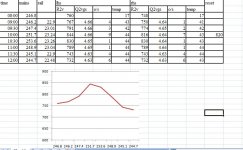I am in the process of getting all the parts together and I do have one question. The Zener
diode 9.1 volt, what wattage are we talking about milliwatts or watts.
diode 9.1 volt, what wattage are we talking about milliwatts or watts.
Just received from Jensen the transformers but there is no wiring diagram of the windings can someone please post a layout please?
Go to the Jensen website and the layout is published there.
http://www.jensen-transformers.com/wp-content/uploads/2014/08/jt-123-flpch.pdf
http://www.jensen-transformers.com/wp-content/uploads/2014/08/jt-123-flpch.pdf
Following on from vitalstates findings in post 461 I rigged my F6 up on the test bench(dining table) for a few hours testing and mine is the same the bias setting will not stay still. With inputs shorted I let the amp warm up for 30 mins and set the bias to .620V across R2(0.47R) and the offset at 2mv. The readings changed all the time over the next 2hrs with the right channel suddenly dropping by 80mv for no apparent reason with the offset rising to 20mv. I reset to .620V and left for a while longer the bias rising to.670V over the next 30 mins. It did not drop below .6V again but fluctuated by 50mv over time again being pretty much the same on both channels.
I hope someone can offer a solution to this problem as this is one fine sounding amp especially when partnered with the BA3 pre which as people have said is one hell of a good preamp.
How much did the board layout change with buzzforb's alterations?
I hope someone can offer a solution to this problem as this is one fine sounding amp especially when partnered with the BA3 pre which as people have said is one hell of a good preamp.
How much did the board layout change with buzzforb's alterations?
temp. interface is of vital importance
mica and goop or Kerafoil , proper torque , proper and steady ventilation
of course , if electrically everything is OK
mica and goop or Kerafoil , proper torque , proper and steady ventilation
of course , if electrically everything is OK
Mica and goop was used with the mosfets nicely tightened to the heatsink and held in place with an alluminium strip 2mm x 20mm. The case base has holes drilled in it and the top is spaced from the the heatsinks by 10mm stand offs so plenty of ventilation. Power supply is running at +-23V.
I will check the temp difference between mosfets and heatsinks.
I will check the temp difference between mosfets and heatsinks.
I have had the amp running for 90 mins and the difference in temp between mosfets and heat sinks is 7C .
The bias had risen to .694 on one channel and .717 on the other. Both were at .675V when I turned it off this afternoon.
Any advise much appreciated.
Marra
The bias had risen to .694 on one channel and .717 on the other. Both were at .675V when I turned it off this afternoon.
Any advise much appreciated.
Marra
Time / heatsink temperature / offset voltage
2min 22C 3.6mV
10min 30C 2.4mV
20min 35C 2.8mV
1h 40C 2.7mV
2h 42C 2.0mV
3h 42C 2.2mV whereafter offset readjusted to 0.0mV
Zeners 5.6V types
Note: mine is a diyAudio circuit, but not a diyAudio PCB
bias is stable
2min 22C 3.6mV
10min 30C 2.4mV
20min 35C 2.8mV
1h 40C 2.7mV
2h 42C 2.0mV
3h 42C 2.2mV whereafter offset readjusted to 0.0mV
Zeners 5.6V types
Note: mine is a diyAudio circuit, but not a diyAudio PCB
bias is stable
have you steady mains voltage ?
I didn't check it today but usually we have around 240V sometimes as high as 245V.
I didn't check it today but usually we have around 240V sometimes as high as 245V.
Do you have large electric appliances nearby that start and stop periodically?
Sometimes even a neighbor's equipment can cause significant line voltage variations.
Nothing out of the ordinary only normal domestic appliances.
The music system is fed from its own spur from the consumer unit.
I have to say that this is the first of Nelsons amps that I have built which hasn't stayed stable once set.
The music system is fed from its own spur from the consumer unit.
I have to say that this is the first of Nelsons amps that I have built which hasn't stayed stable once set.
Last edited:
Nothing out of the ordinary only normal domestic appliances.
The music system is fed from its own spur from the consumer unit.
I have to say that this is the first of Nelsons amps that I have built which hasn't stayed stable once set.
+1
this is the first of Nelson's which wont stay stable.
My mains fluctuates between 242v and 253 but it's usually stable over 1 day.
I have a brand new set of matched 240s waiting to be swapped in and I'm just waiting for mica pads to be delivered. I will post the results after the update, together with mains voltages.
I was suffering from audio psychosis so any report on the actual sound quality would be a bit tainted. Once you measure something awry the effect creeps into your appreciation of the music.
My first impressions before I started all the measurements were'nt satisfactory though.
Ed
I've been messing and measuring the F6 for the build guide, made with the most recent iteration of the PCB and haven't seen much of an offset drift at all. I was seeing some weirdness in bias current jumping around, but using a different multimeter has seemed to fixed that problem... 🙂 Lol.
The one thing worth commenting on is the sound -- this is a very, very nice amplifier. I'm very much enjoying it, and would recommend it heartily to anybody interested in the Firstwatt projects.
A limited supply of PCB only will be available in the store soon, and slightly after that, a bundle of the PCB and the Jensen transformers will be offered.
The one thing worth commenting on is the sound -- this is a very, very nice amplifier. I'm very much enjoying it, and would recommend it heartily to anybody interested in the Firstwatt projects.
A limited supply of PCB only will be available in the store soon, and slightly after that, a bundle of the PCB and the Jensen transformers will be offered.
F6 update:
continuing my pursuit of fluctuating bias.
The original 240s have been replaced with a new set of matched 240s. The silpads have been replaced with mica and goop. I've attached the table of measurements with the new set up....a bit limited but I think it tells the story....Mighty ZM was on the money with his idea of mains fluctuations. I hadn't realised the huge changes that occur with my mains over short periods of time.
I've managed to get the 2 channels to track more or less together and set the offset to centre in the middle of my mains variance so it's down to listening now to see whether these variations really do affect the sound.
Any UK builders that have mains fluctuations like me might like to post their experiences.
continuing my pursuit of fluctuating bias.
The original 240s have been replaced with a new set of matched 240s. The silpads have been replaced with mica and goop. I've attached the table of measurements with the new set up....a bit limited but I think it tells the story....Mighty ZM was on the money with his idea of mains fluctuations. I hadn't realised the huge changes that occur with my mains over short periods of time.
I've managed to get the 2 channels to track more or less together and set the offset to centre in the middle of my mains variance so it's down to listening now to see whether these variations really do affect the sound.
Any UK builders that have mains fluctuations like me might like to post their experiences.
Attachments
......Mighty ZM was on the money with his idea of mains fluctuations. ......

I believe there is same saying all around the world , but I'll translate it literally from Serbian :
"even blind hen sometimes find a grain"
Working on the build guide. This is not done yet! But if you want a preview... 🙂
PCB will be available in the store hopefully late next week. (Along with matched Jfet)
``````````````````````````````````````````````
Mosfet F6 Illustrated Build Guide
The Firstwatt F6 is a power amplifier from the brilliant mind of our technical, spiritual, and menu advisor, Nelson Pass.
This guide uses this PCB set — LINK
SCHEMATIC
The Schematic can be found here -
IMAGE
And an example PSU is here -
IMAGE
BOM NOTES
CHASSIS
The example amp is build into a diyAudio Deluxe 4U chassis — LINK
ASSEMBLY
Here are the PCB. The production boards are blue, and have some very slight changes to the silkscreen, but are otherwise identical.
Note that the PCB are a matched pair, not 2 of the same PCB. This is to facilitate keeping the input transformer as close to the back wall (and away from the power transformer) as possible.
Stuff resistors first.
After the resistors, stuff the larger components. Jfets, pots, capacitors, etc…
A stuffed PCB, sans transformer and LEDs (Didn’t have any blue ones on hand. 🙂 )

Input transformer. Note that on pair of pins is slightly narrower than the others. There are corresponding pads on the PCB for the narrow pins.
Transformer mounts here.

Both transformer mounted.
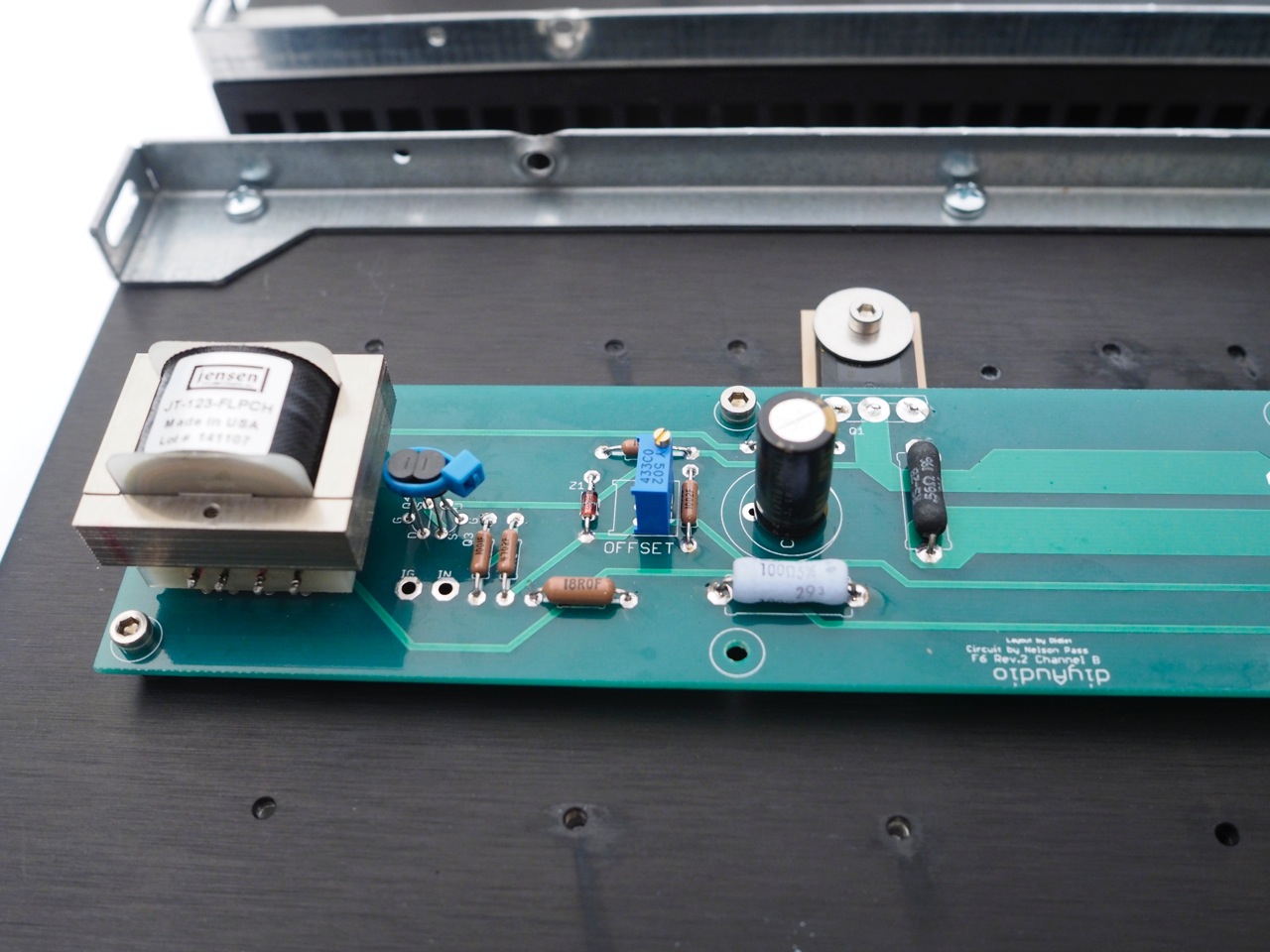
Remember, for best heatsink use, the mosfet should mount towards the bottom. This heatsink will make the left wall of the case.
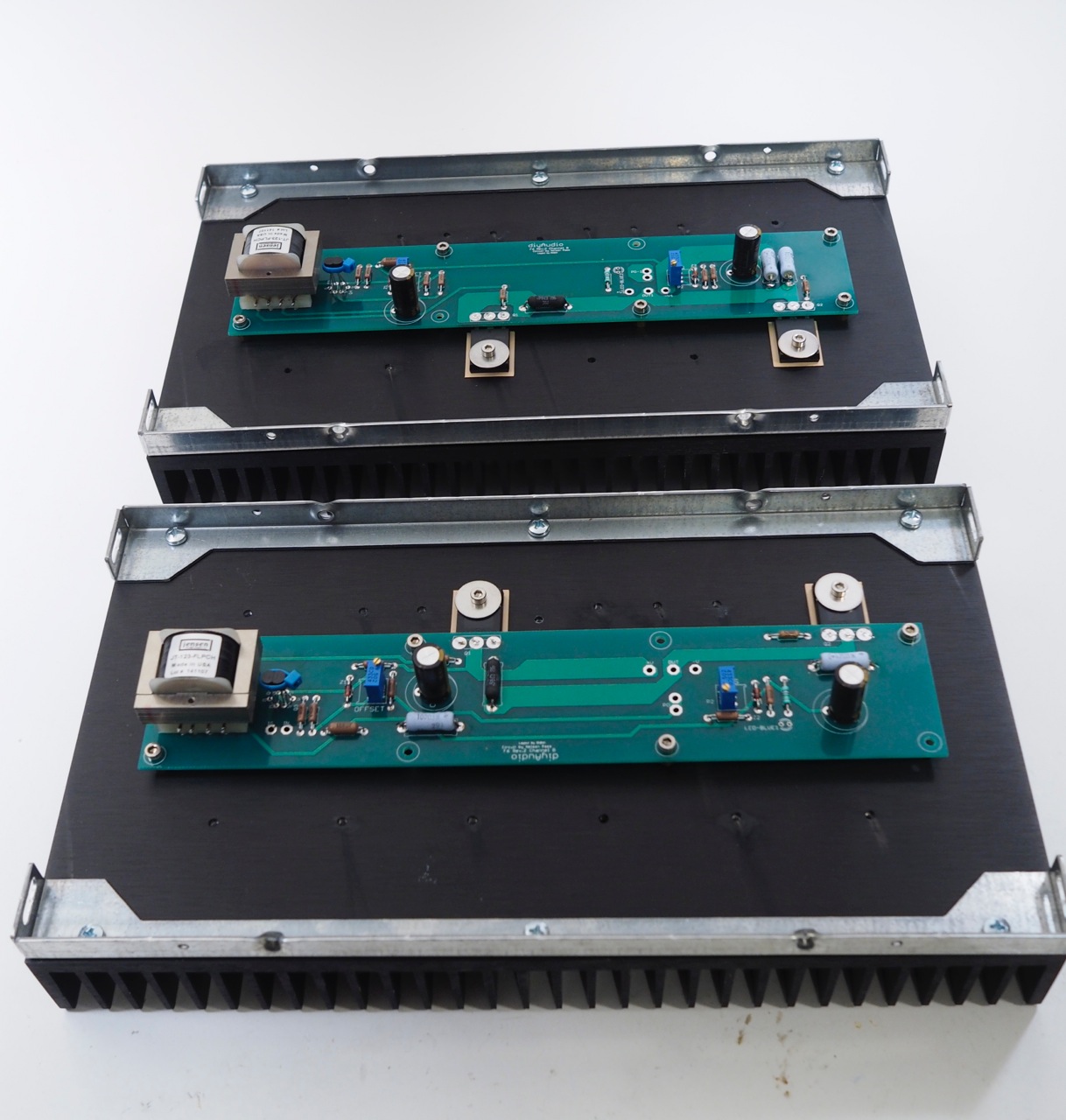
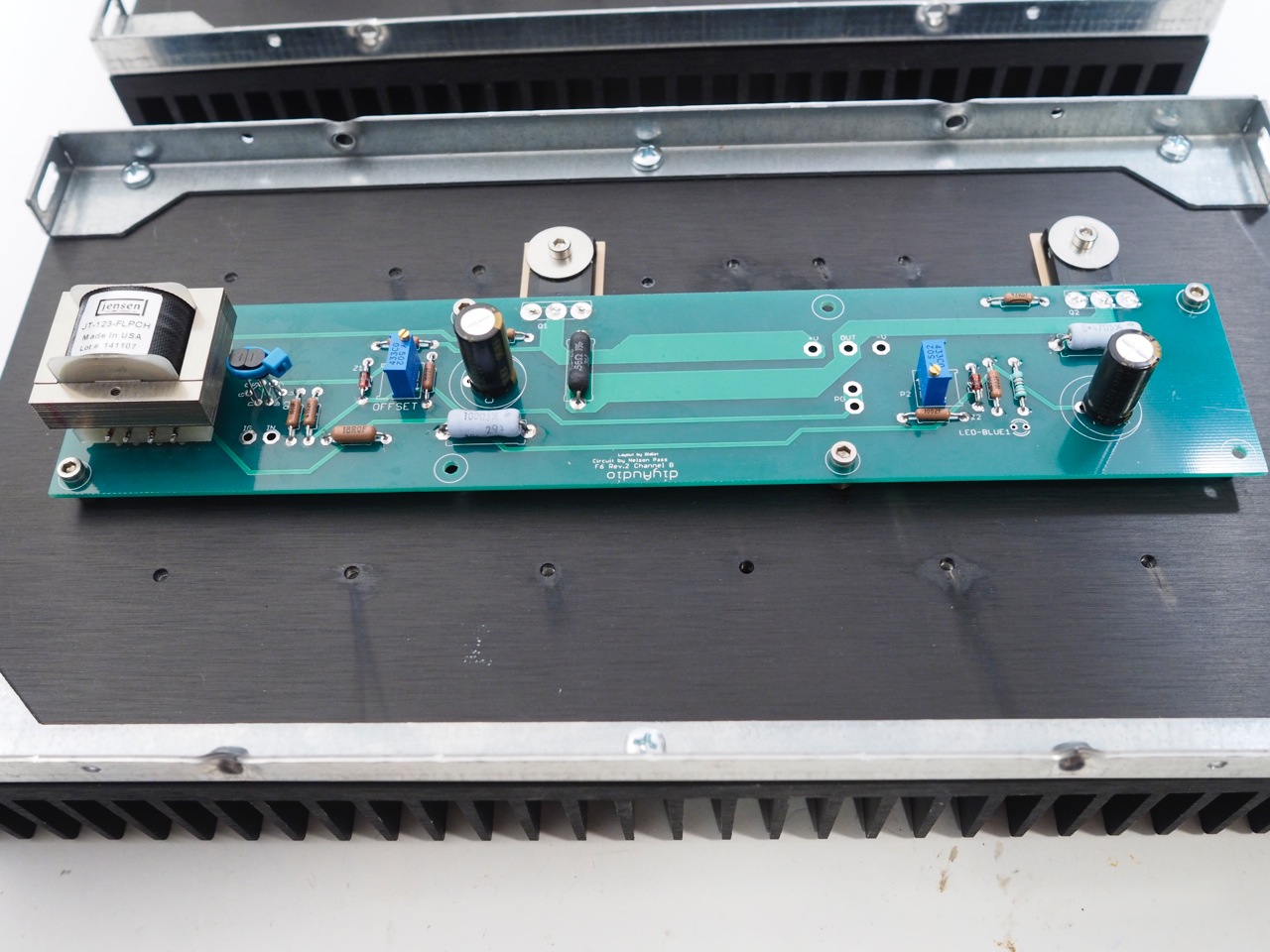
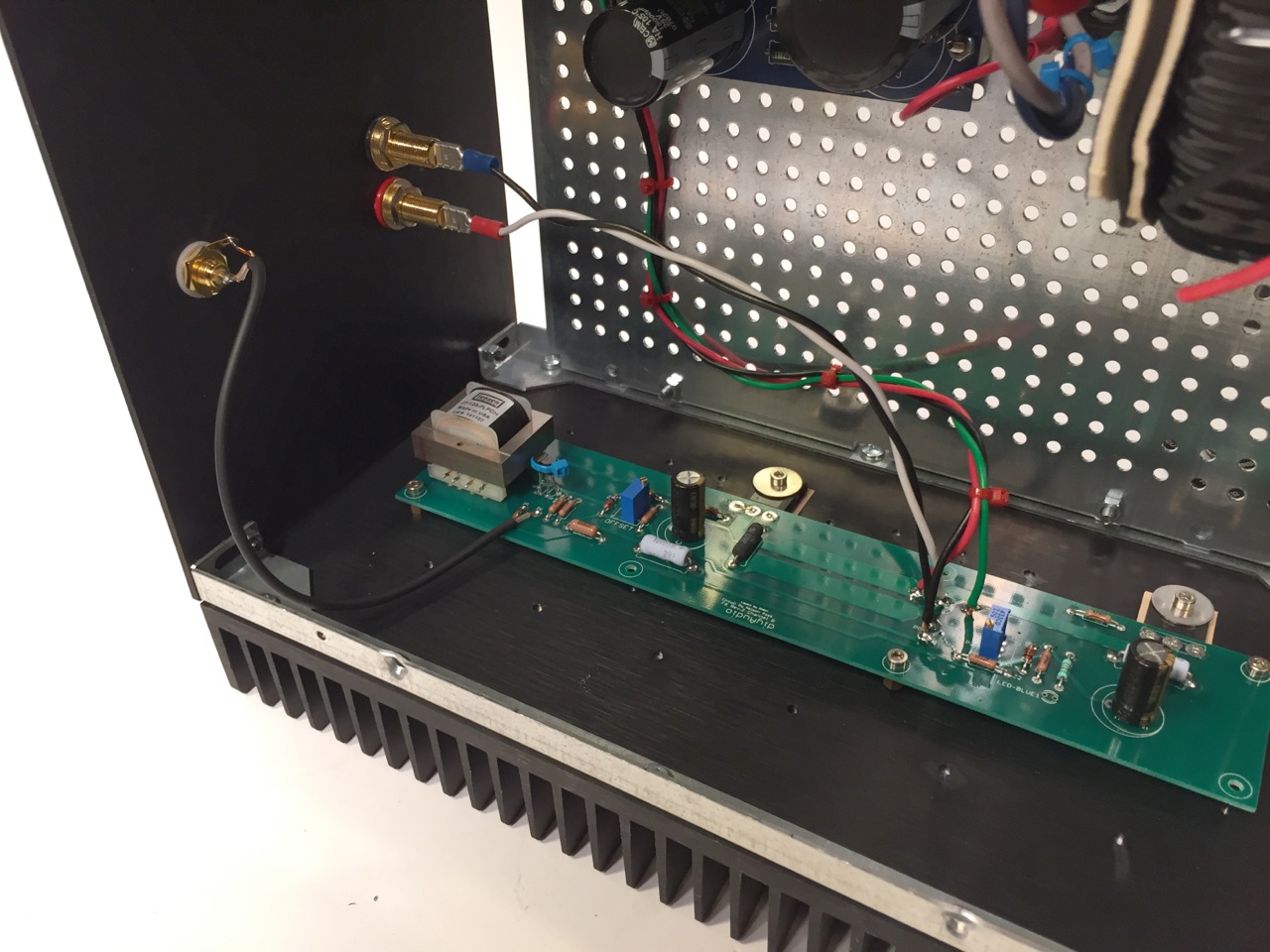
You can see all the wiring of the PCB in this photo. (Red Black Green) is from the PSU, (Black White) is to the speaker posts, and the thin coax connects RCA to input.
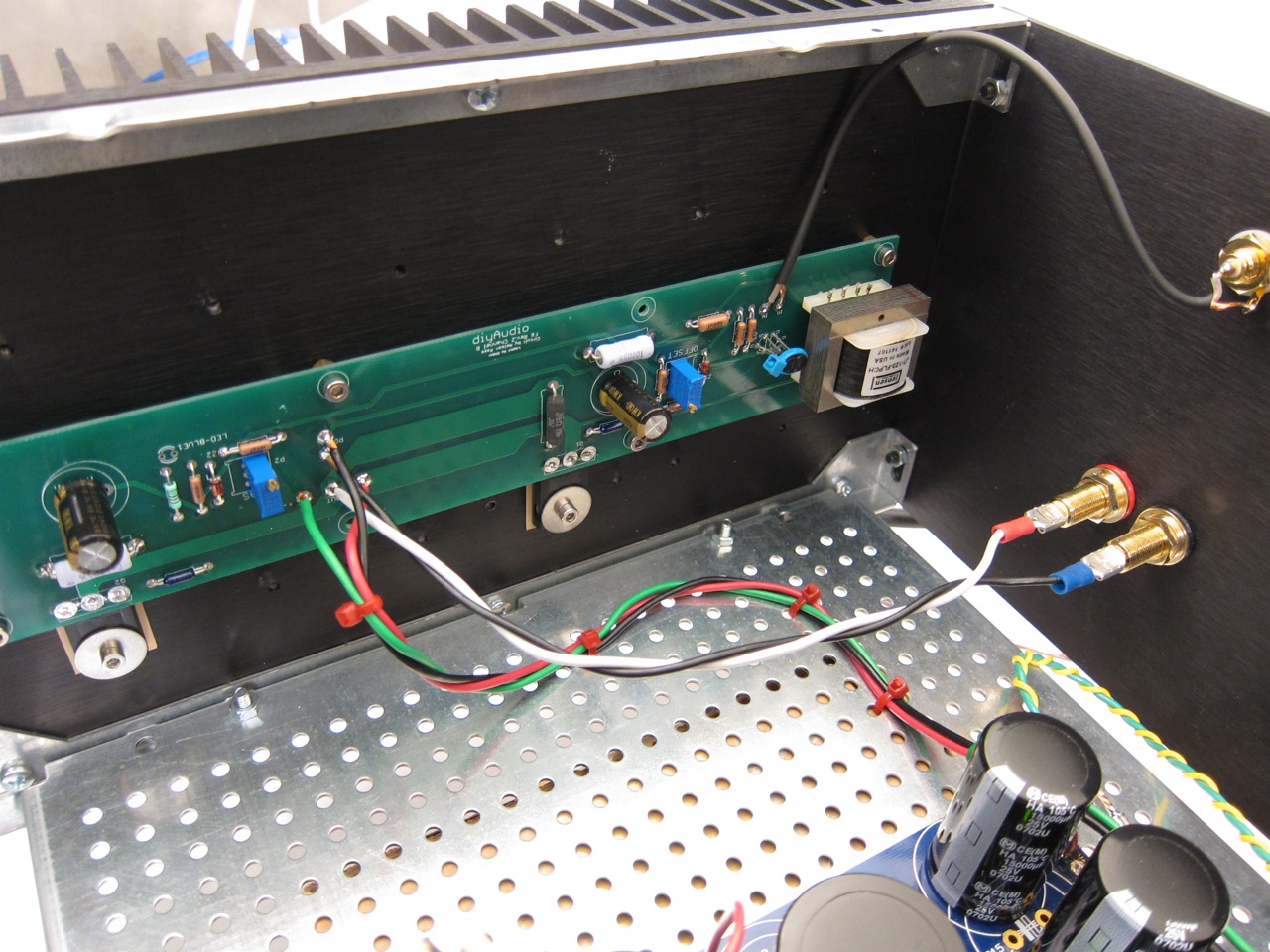
Black is PSU GND and Speaker negative
White is Speaker positive
Red is V+
Green is V-
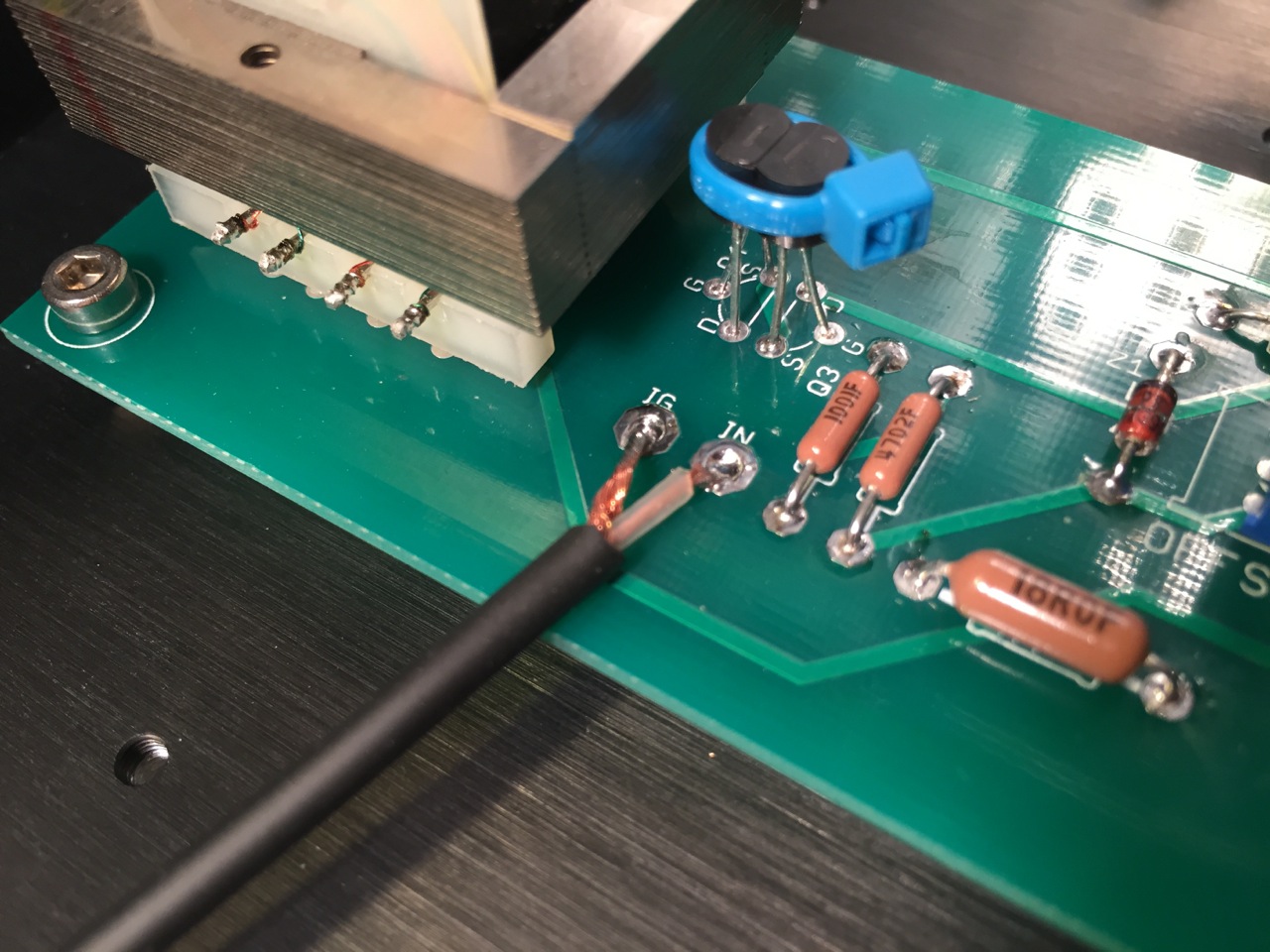
Input wiring from RCA
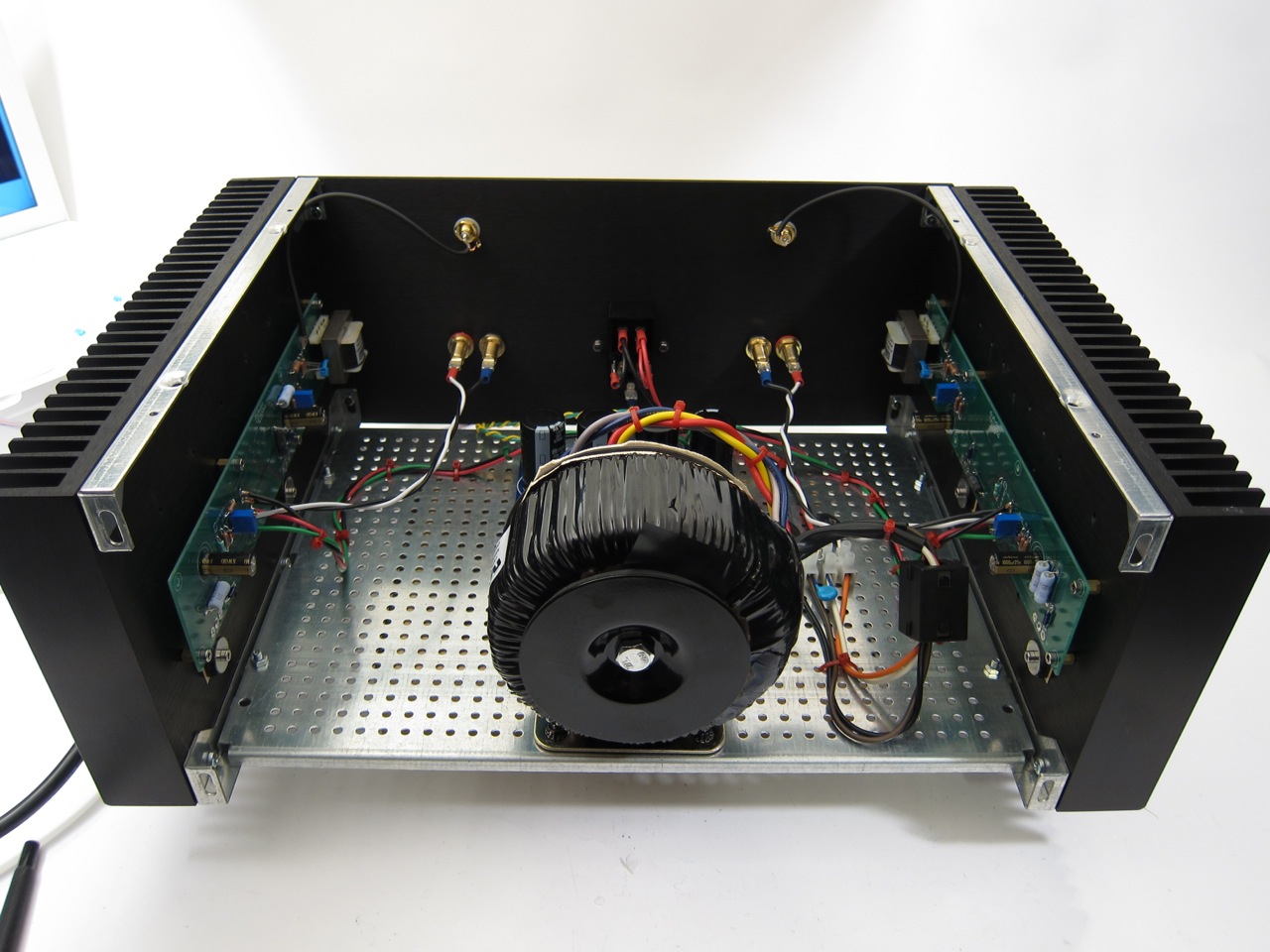
Completed, working amp. Need only to finish assembling the chassis around it.
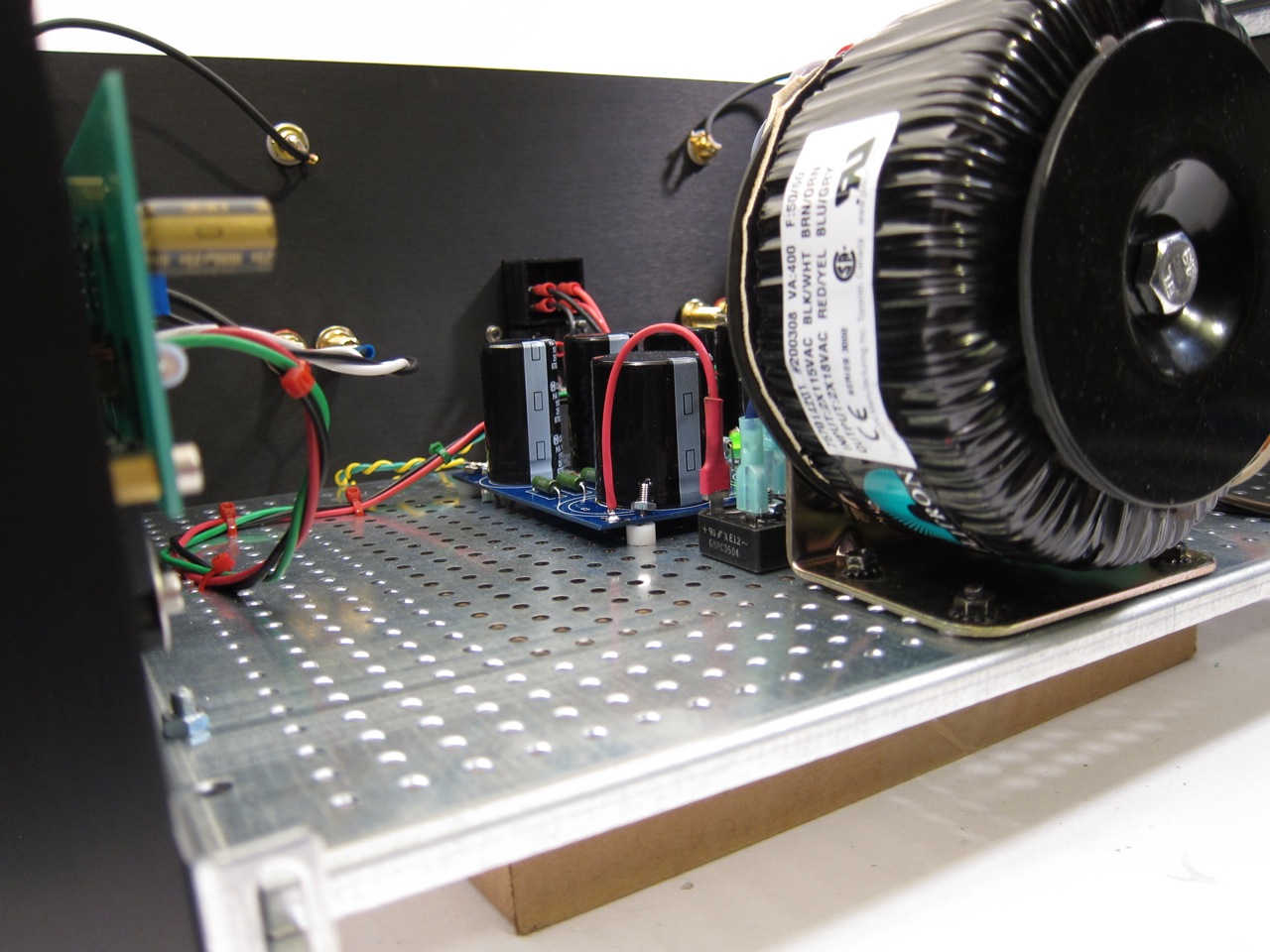
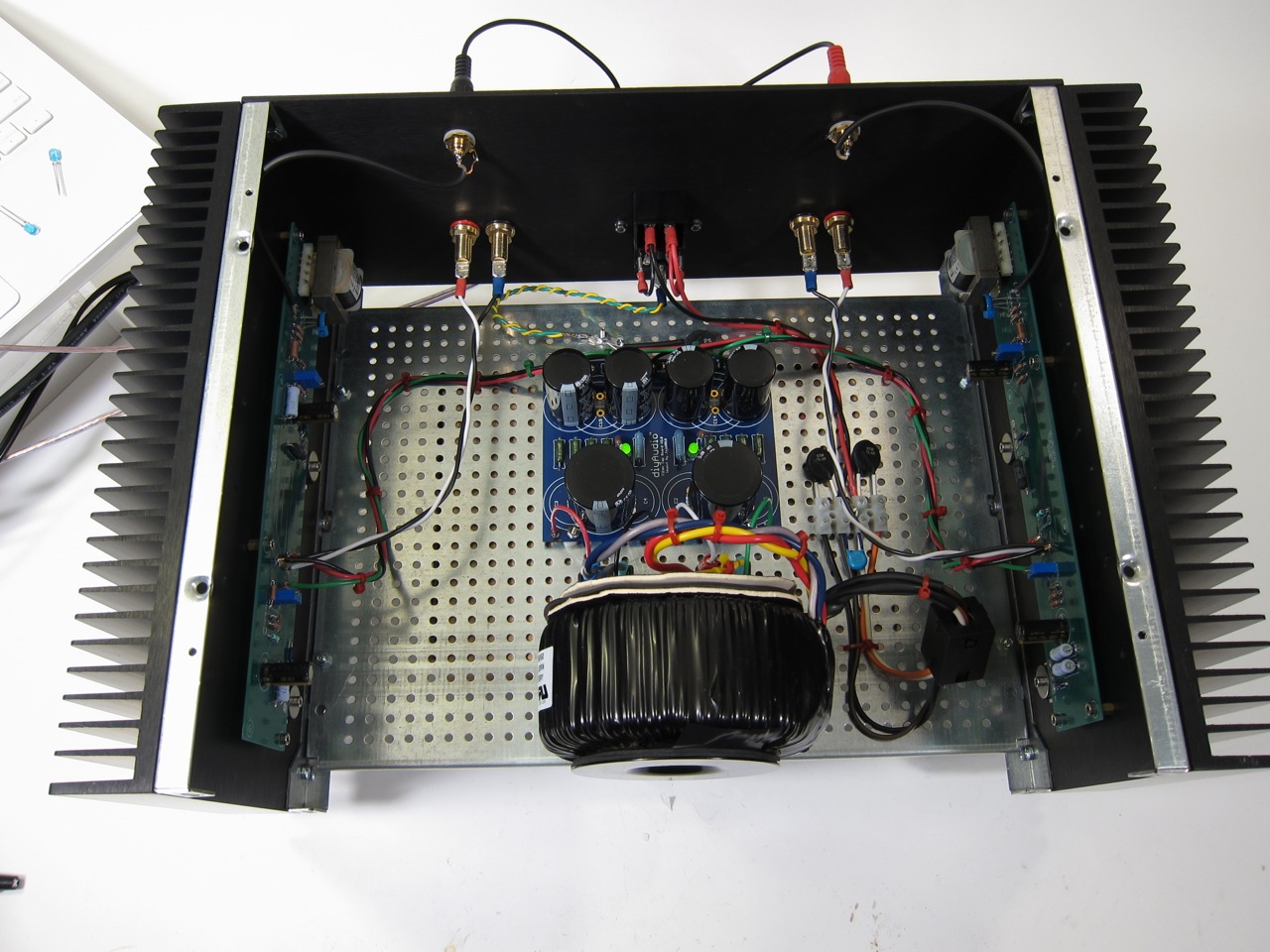
POWER SUPPLY

IEC socket. You must wire the fuse holder to the switch as shown.
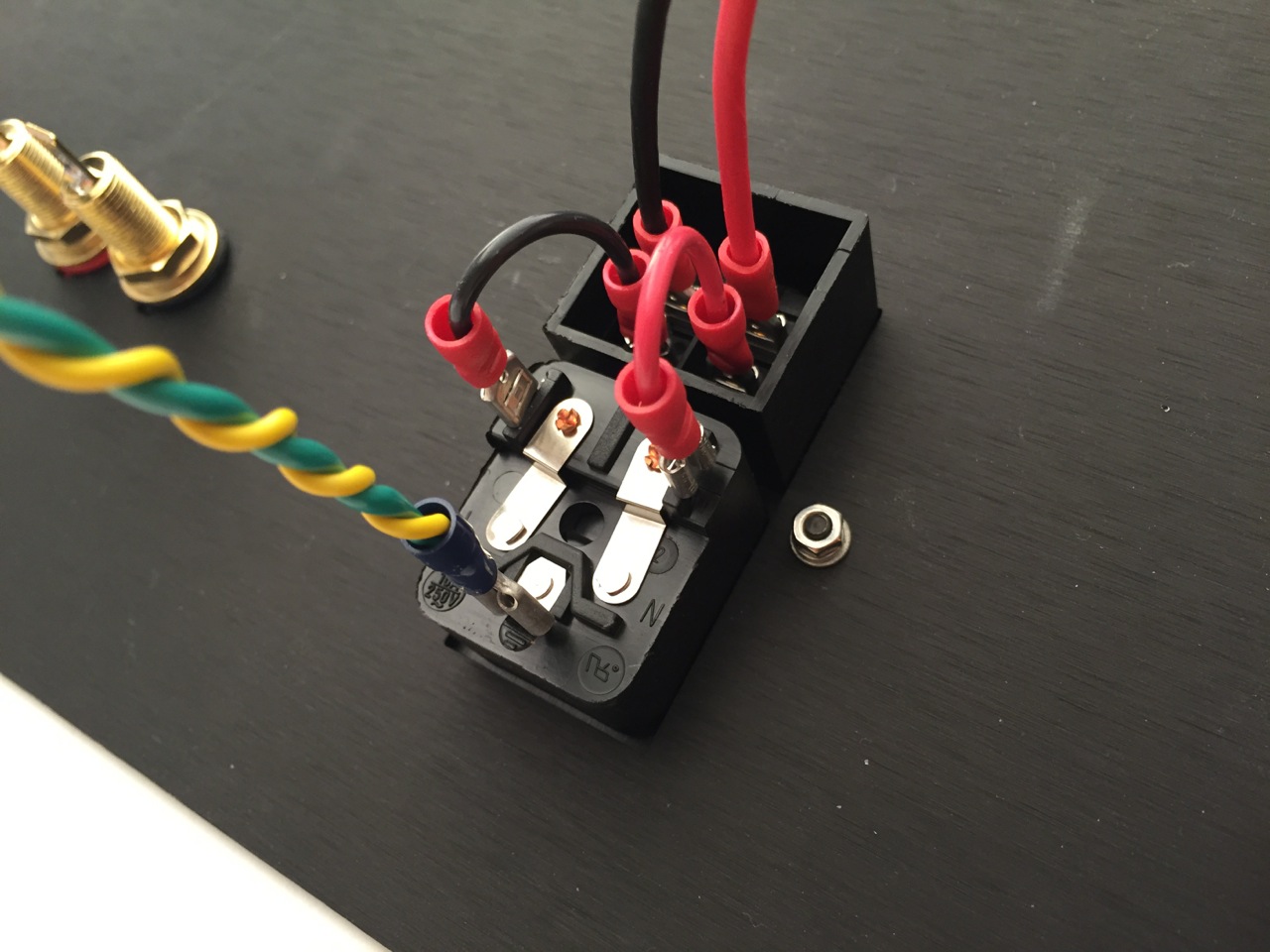
The long wires go to the terminal block with CL-60s, line cap and then the transformer primaries. I needed a bit huskier wire for the safety earth, and added the yellow for clarity.
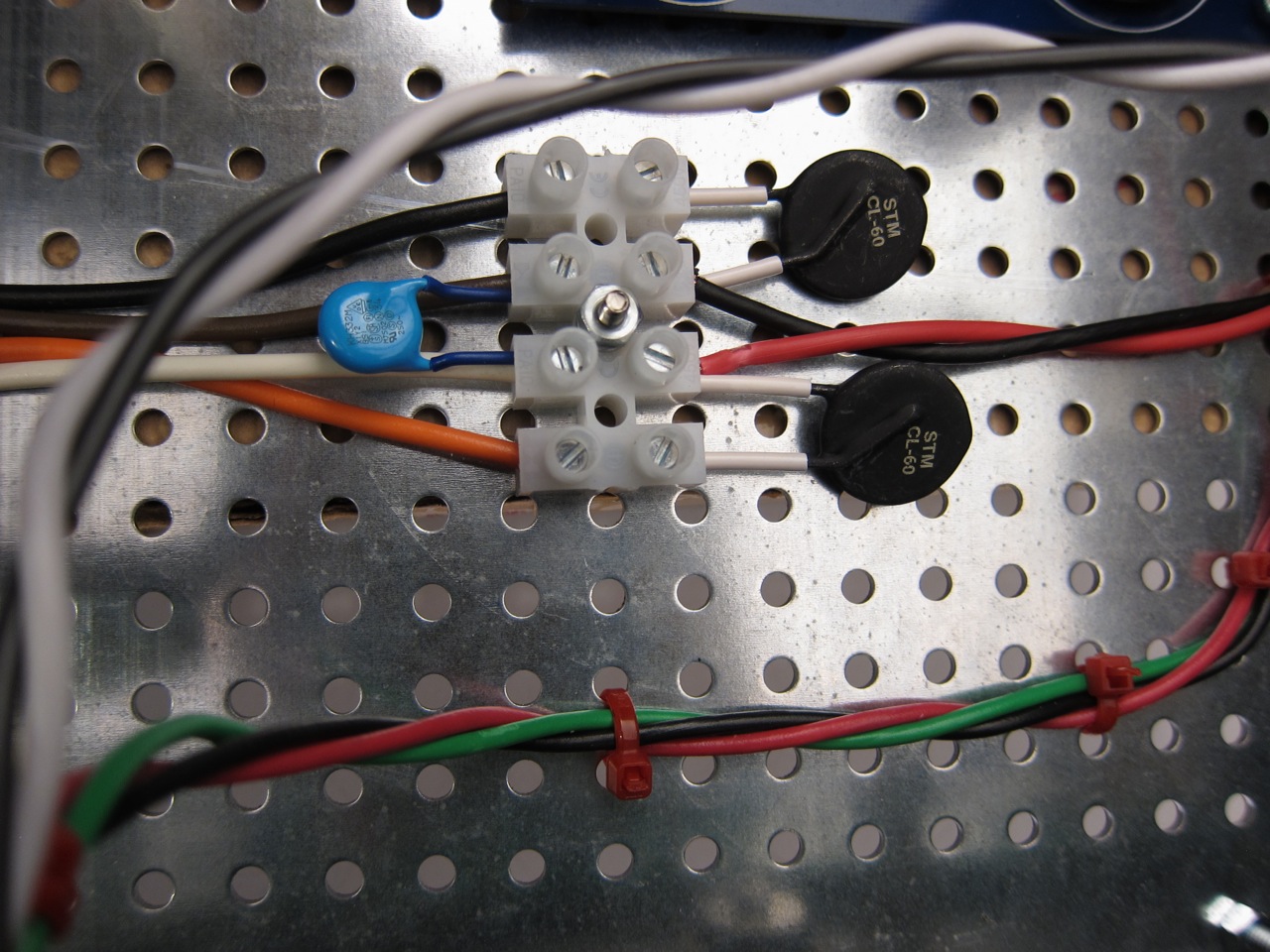
Into the block you can see the thermistors and cap, the AC mains from the IEC switch (Red Black) and the transformer primaries (Black Brown White Orange)
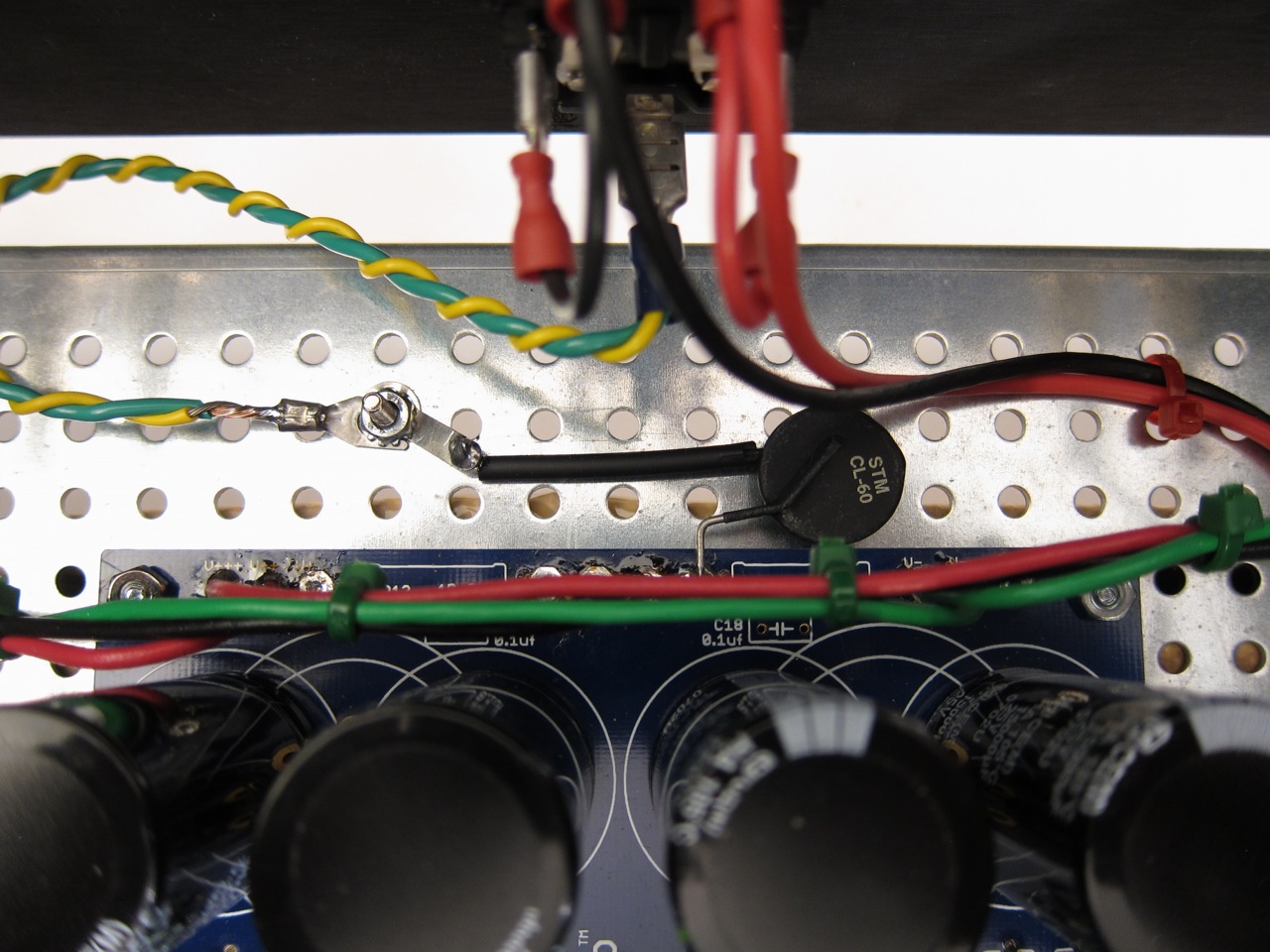
Safety earth and the CL-60 used to elevate PSU ground.
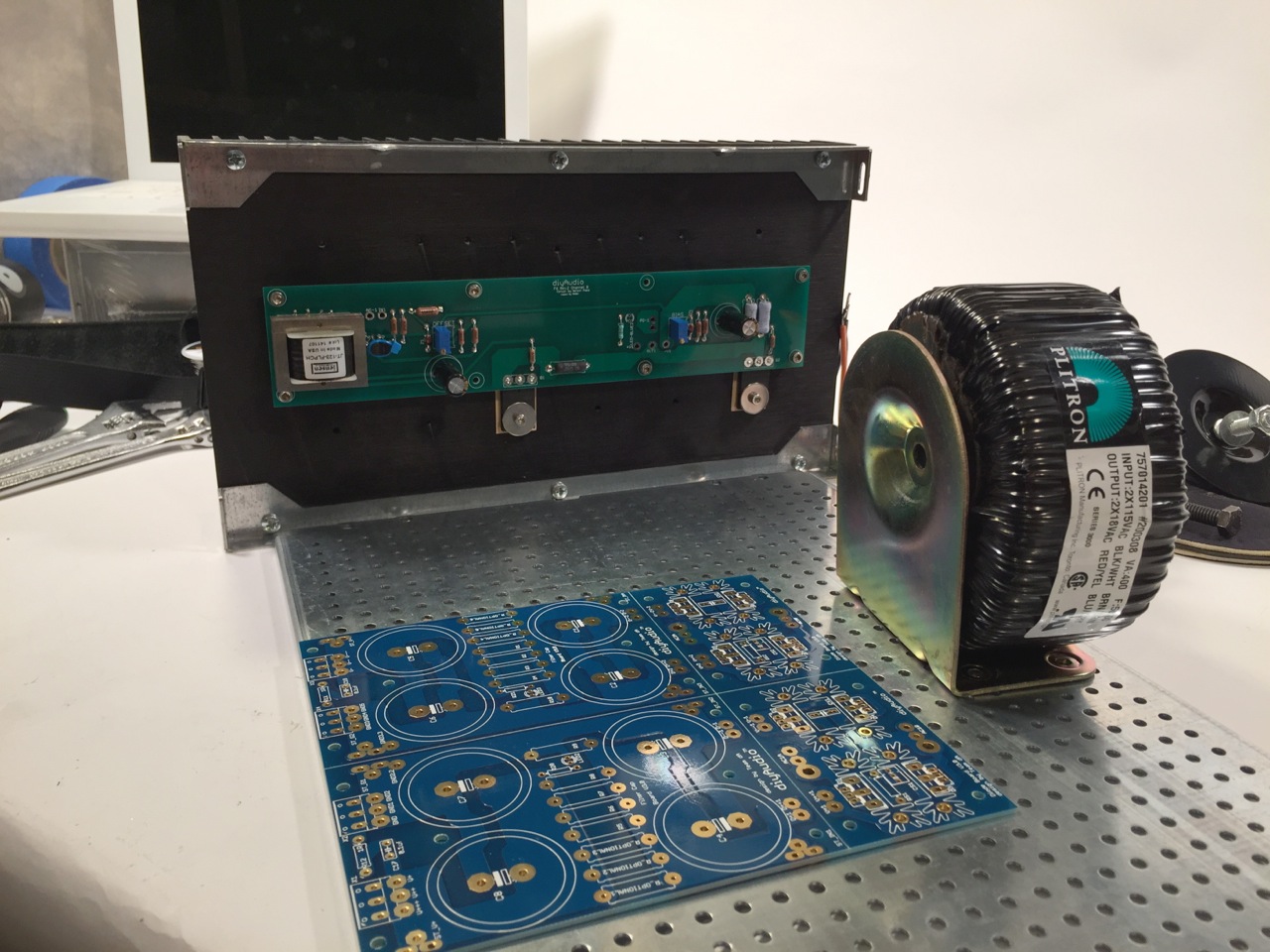
Two things to note - 1) I didn’t know if the power transformer was going to magnetically couple with the input transformers, so I wanted it as far away as possible. This will be almost touching the front plate. The L bracket was something I had from a salvage broken amp, so I can’t suggest a part number. Sorry. 2) Although I didn’t use the current PSU PCB, you can see that there is sufficient room (barely) for the board you can buy from the store.
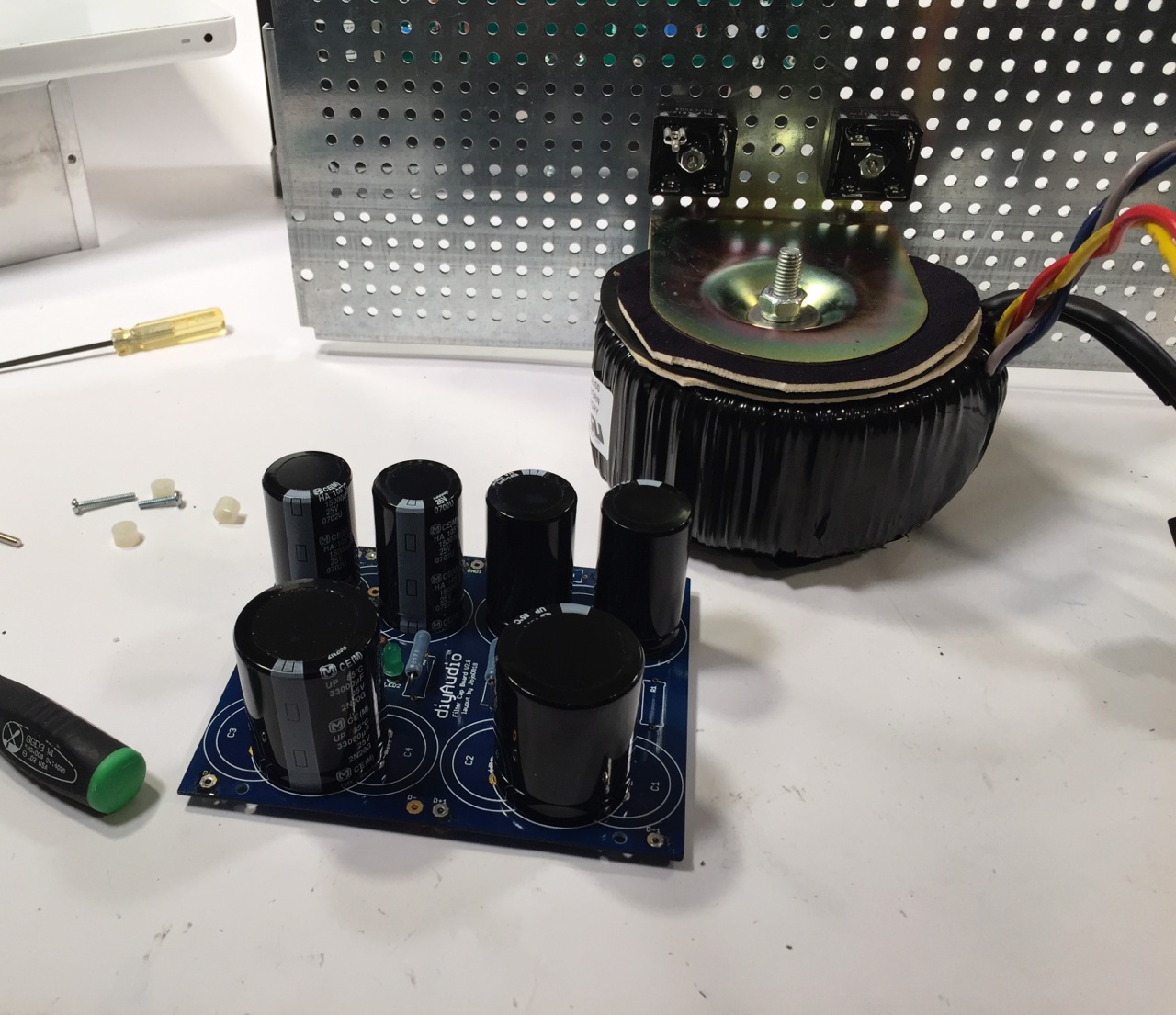
I used an older diyAudio PCB that I had on hand, mainly because I really wanted to use it up.
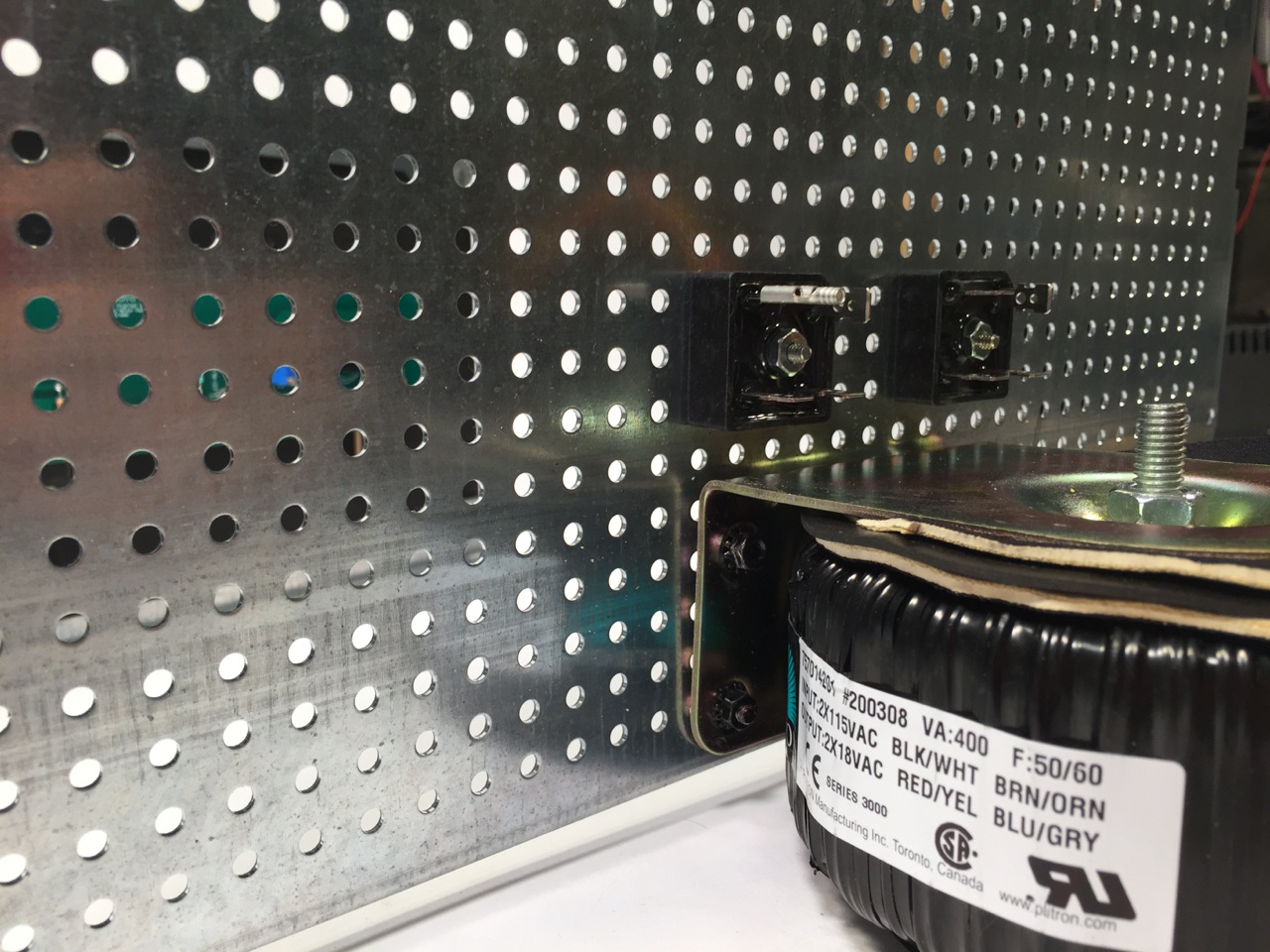
Bridges mounted.
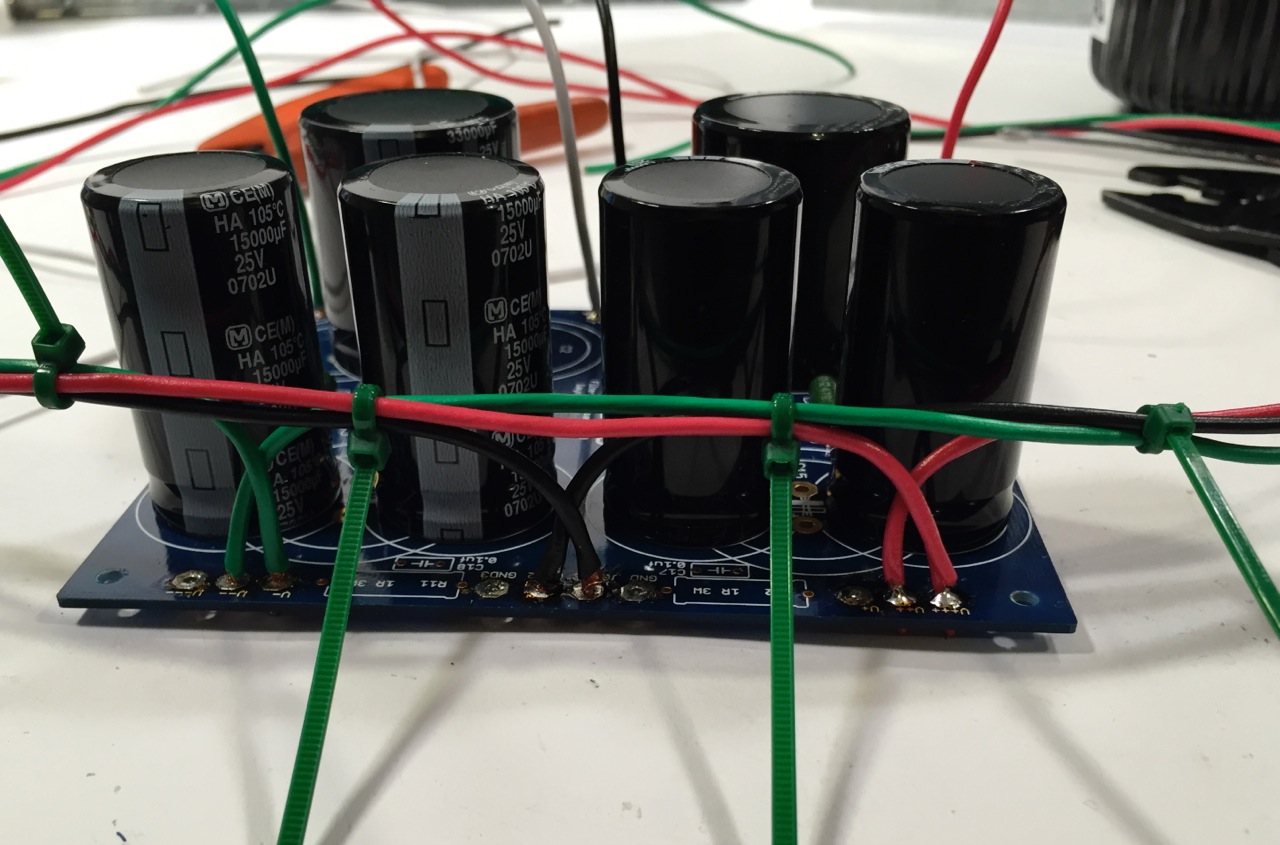
Wiring up the PCB.
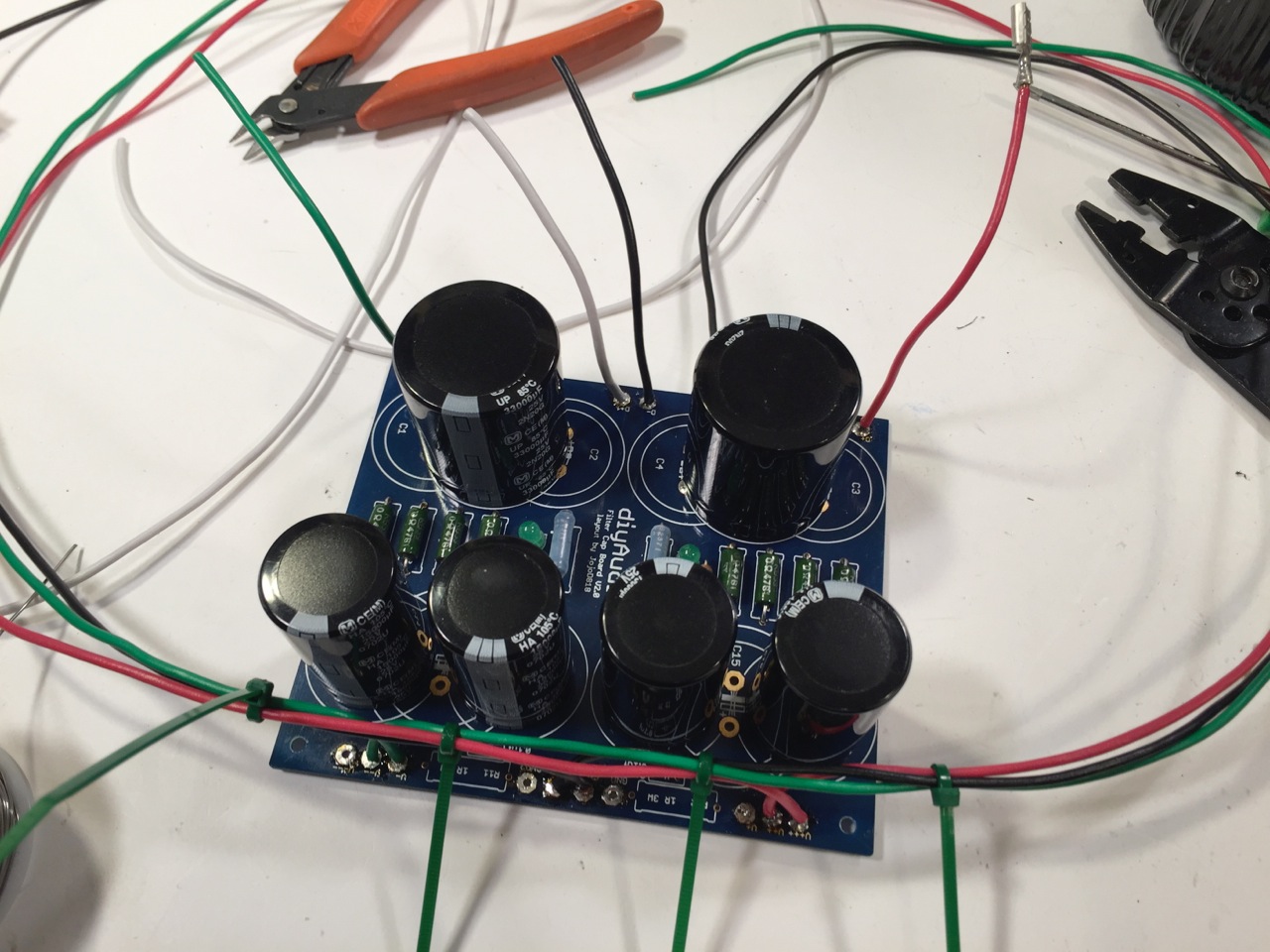
More wiring.
For those of you wondering why I choose to have 2 big caps on one side and 4 on the other, it’s simply because I had those caps in my box. There’s no gain nor detriment to doing it in this manner.
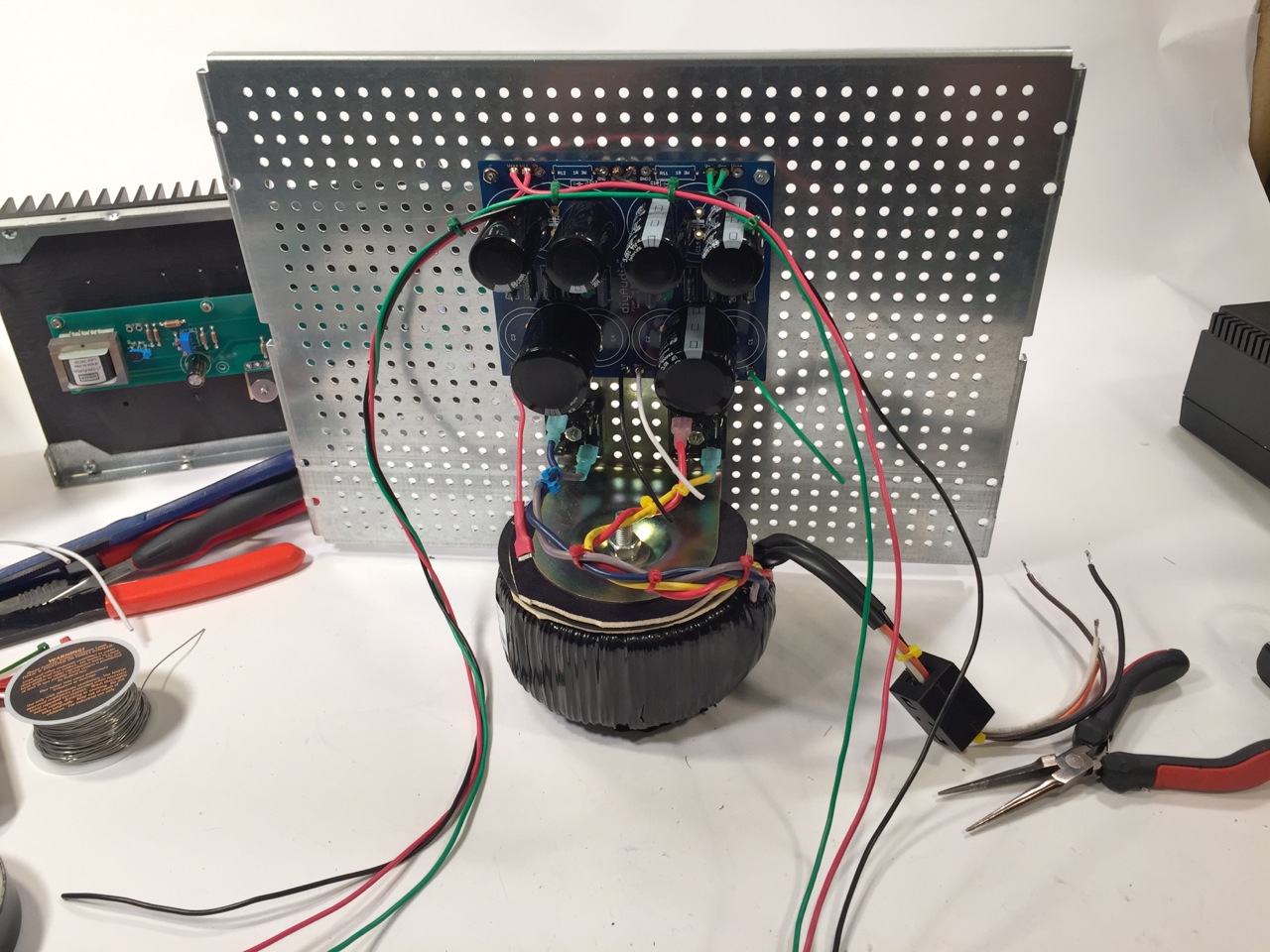

The secret to clean wiring? Simple - start with your leads overly long and trim as you need to, and use lots of zipties. 😀
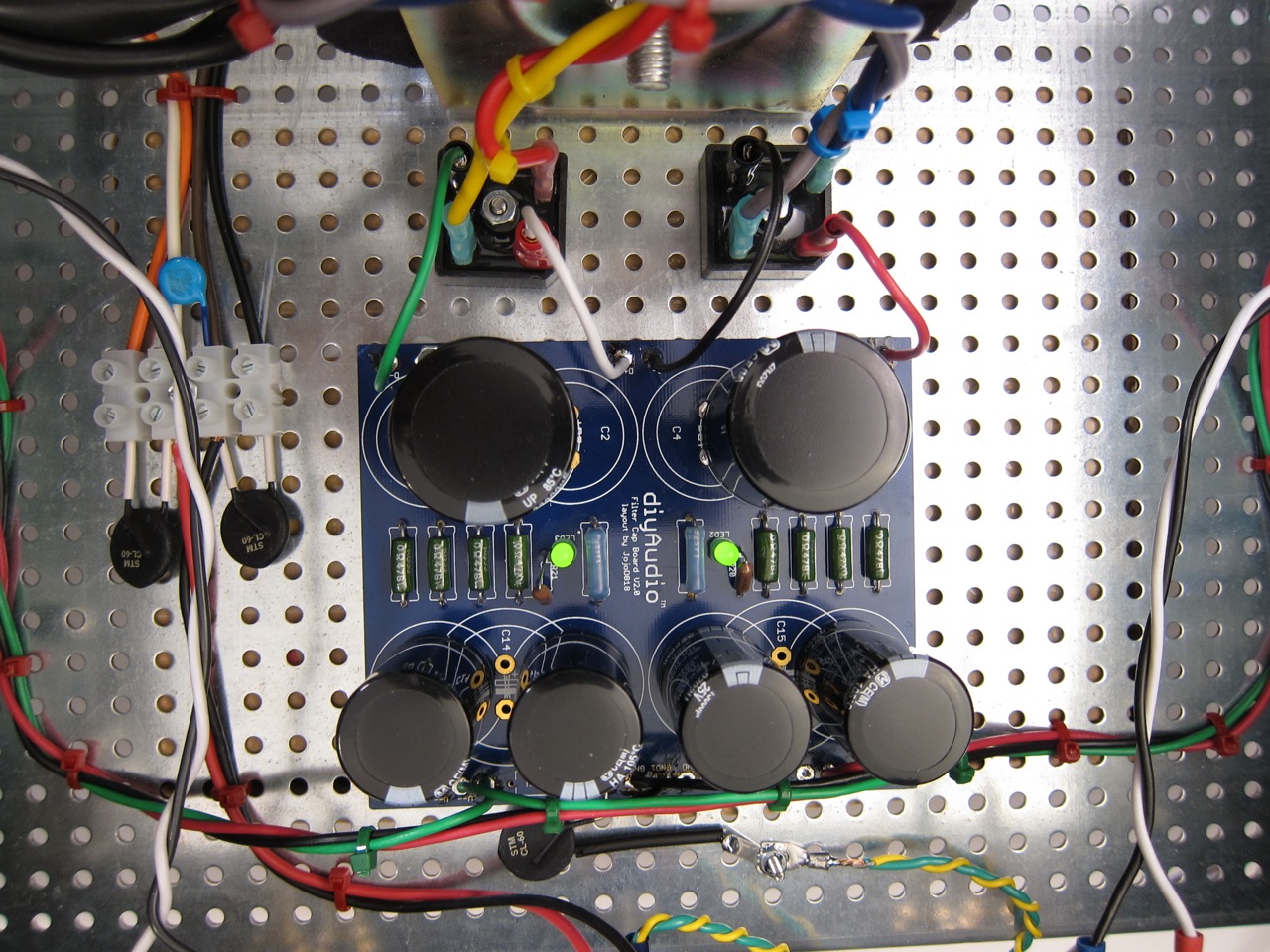
You can see the connections from transformer secondary to bridges and from bridges to PSU board.
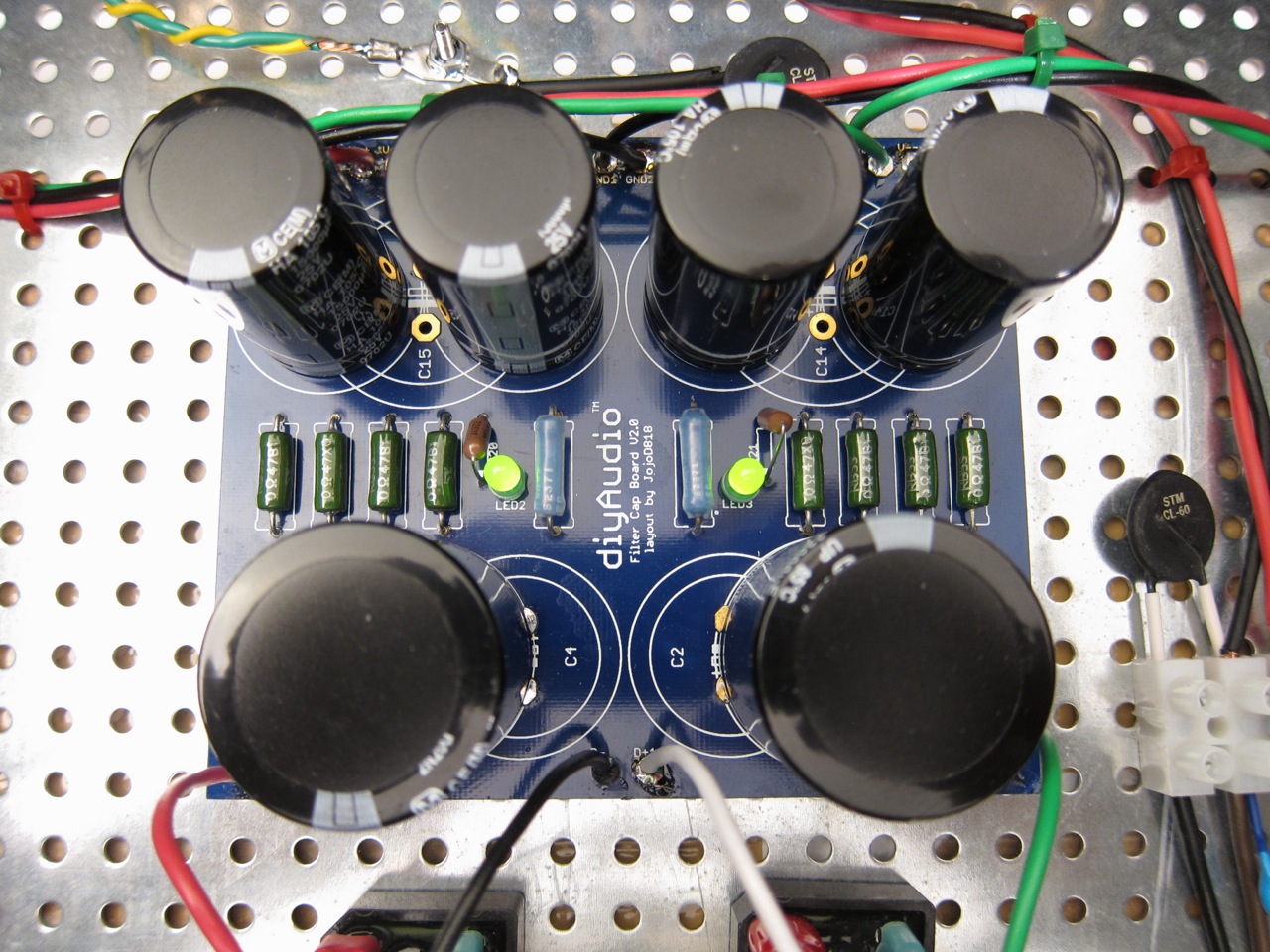
PSU lit up.
TESTING AND POWERUP
BIAS
OFFSET
PCB will be available in the store hopefully late next week. (Along with matched Jfet)
``````````````````````````````````````````````
Mosfet F6 Illustrated Build Guide
The Firstwatt F6 is a power amplifier from the brilliant mind of our technical, spiritual, and menu advisor, Nelson Pass.
This guide uses this PCB set — LINK
SCHEMATIC
The Schematic can be found here -
IMAGE
And an example PSU is here -
IMAGE
BOM NOTES
CHASSIS
The example amp is build into a diyAudio Deluxe 4U chassis — LINK
ASSEMBLY
Here are the PCB. The production boards are blue, and have some very slight changes to the silkscreen, but are otherwise identical.
Note that the PCB are a matched pair, not 2 of the same PCB. This is to facilitate keeping the input transformer as close to the back wall (and away from the power transformer) as possible.
Stuff resistors first.
After the resistors, stuff the larger components. Jfets, pots, capacitors, etc…
A stuffed PCB, sans transformer and LEDs (Didn’t have any blue ones on hand. 🙂 )

Input transformer. Note that on pair of pins is slightly narrower than the others. There are corresponding pads on the PCB for the narrow pins.
Transformer mounts here.

Both transformer mounted.

Remember, for best heatsink use, the mosfet should mount towards the bottom. This heatsink will make the left wall of the case.



You can see all the wiring of the PCB in this photo. (Red Black Green) is from the PSU, (Black White) is to the speaker posts, and the thin coax connects RCA to input.

Black is PSU GND and Speaker negative
White is Speaker positive
Red is V+
Green is V-

Input wiring from RCA

Completed, working amp. Need only to finish assembling the chassis around it.


POWER SUPPLY

IEC socket. You must wire the fuse holder to the switch as shown.

The long wires go to the terminal block with CL-60s, line cap and then the transformer primaries. I needed a bit huskier wire for the safety earth, and added the yellow for clarity.

Into the block you can see the thermistors and cap, the AC mains from the IEC switch (Red Black) and the transformer primaries (Black Brown White Orange)

Safety earth and the CL-60 used to elevate PSU ground.

Two things to note - 1) I didn’t know if the power transformer was going to magnetically couple with the input transformers, so I wanted it as far away as possible. This will be almost touching the front plate. The L bracket was something I had from a salvage broken amp, so I can’t suggest a part number. Sorry. 2) Although I didn’t use the current PSU PCB, you can see that there is sufficient room (barely) for the board you can buy from the store.

I used an older diyAudio PCB that I had on hand, mainly because I really wanted to use it up.

Bridges mounted.

Wiring up the PCB.

More wiring.
For those of you wondering why I choose to have 2 big caps on one side and 4 on the other, it’s simply because I had those caps in my box. There’s no gain nor detriment to doing it in this manner.


The secret to clean wiring? Simple - start with your leads overly long and trim as you need to, and use lots of zipties. 😀

You can see the connections from transformer secondary to bridges and from bridges to PSU board.

PSU lit up.
TESTING AND POWERUP
BIAS
OFFSET
Last edited:
- Home
- Amplifiers
- Pass Labs
- The diyAudio Firstwatt F6
